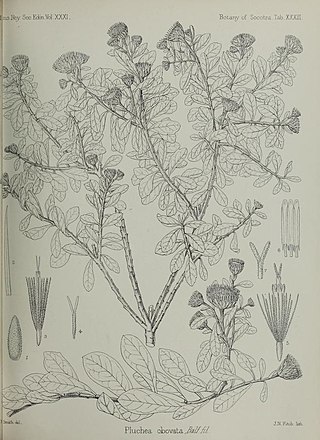
Magnolia officinalis is a species of Magnolia native to the mountains and valleys of China at altitudes of 300–1500 m.

Picea obovata, the Siberian spruce, is a spruce native to Siberia, from the Ural Mountains east to Magadan Oblast, and from the Arctic tree line south to the Altay Mountains in northwestern Mongolia.
Abarema obovata, the obovate abarema, is a species of plant in the family Fabaceae. It is endemic to the wooded hillsides of east and north-central Minas Gerais, Brazil.

Pluchea obovata is a species of flowering plant in the family Asteraceae. It is endemic to Socotra. Its natural habitat is rocky areas.
Draba obovata is a species of plant in the family Brassicaceae. It is endemic to Ecuador. Its natural habitats are subtropical or tropical high-altitude grassland and rocky areas. It is an IUCN Red List Near threatened species, threatened by habitat loss.
Dirichletia obovata, synonym Carphalea obovata, is a species of plant in the family Rubiaceae. It is endemic to Socotra. Its natural habitat is subtropical or tropical dry forests.
Freziera obovata is a species of plant in the Pentaphylacaceae family. It is endemic to Ecuador.
Haya is a monotypic genus of plant in the family Caryophyllaceae. It is endemic to Yemen's Socotra island. As of March 2014 The Plant List recognises the single species Haya obovata. Haya obovata grows in subtropical or tropical dry shrubland and rocky areas.
Iryanthera campinae is a species of plant in the family Myristicaceae. It is endemic to Brazil.
Iryanthera is a flowering plant genus in the family Myristicaceae.
Iryanthera megistocarpa is a species of plant in the family Myristicaceae. It is endemic to Panama. It is threatened by habitat loss.

Melicope obovata, also called Makawao melicope or ovate melicope, was a species of plant in the family Rutaceae. It was endemic to the Hawaiian Islands.
Monnina obovata is a species of plant in the family Polygalaceae. It is endemic to Ecuador.
Myrsine obovata is a species of plant in the family Primulaceae. It is endemic to French Polynesia.
Schoepfia harrisii is a species of flowering plant in the Schoepfiaceae family. It is a small tree or shrub, growing two to five metres tall. It is endemic to Jamaica, where it is only known to occur in the parishes of Trelawny and Clarendon, in what is known as Cockpit Country, a region of many steep, rounded, limestone hills, shaped like an egg-carton. Here it grows on crags in moist woodland, between 600 and 900m in elevation.
Semecarpus obovatus is a species of plant in the family Anacardiaceae. It is endemic to Sri Lanka. The specific epithet was originally spelt obovata.
Vatica obovata is a species of plant in the family Dipterocarpaceae. It is a tree endemic to Sumatra. It is a critically endangered species threatened by habitat loss.
Xylosma obovata is a species of flowering plant in the family Salicaceae. It is endemic to Colombia.

Kandelia obovata is a species of plant in the Rhizophoraceae family, i.e. a kind of mangrove. It is found in Vietnam, Natuna Islands of Indonesia, Southern China, Hong Kong, Taiwan, and Japan. Its presence in the Philippines is possible but not confirmed.

Cornutia obovata is a rare species of tree in the mint family, and formerly considered a member of the verbena family. It is endemic to forested slopes in Puerto Rico, where its common names are capá jigüerilla, nigua, and palo de nigua. When it was added to the endangered species list of the United States in 1988 there were only seven individuals known to remain in the wild. By 1998 there were eight plants known. This is considered one population divided amongst a few locations in the mountain forests of the island.






